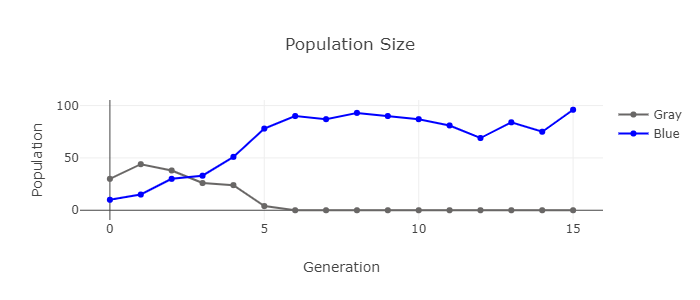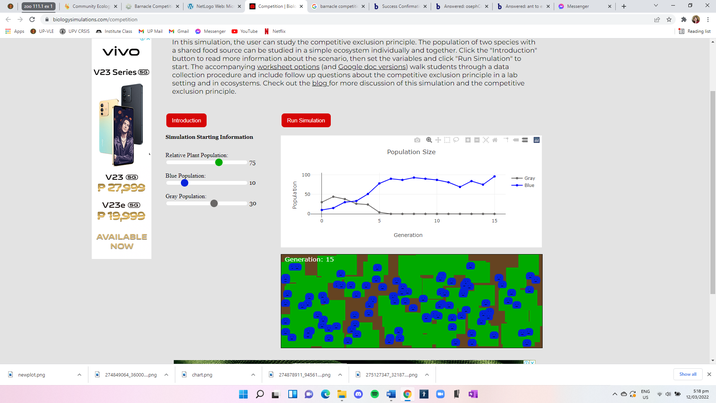Biology Today and Tomorrow without Physiology (MindTap Course List)
5th Edition
ISBN:9781305117396
Author:Cecie Starr, Christine Evers, Lisa Starr
Publisher:Cecie Starr, Christine Evers, Lisa Starr
Chapter16: Population Ecology
Section: Chapter Questions
Problem 2SQ
Related questions
Question
give the results, discussion and conclusion based on the images given.

Transcribed Image Text:Population Size
100
Gray
Blue
50
5
10
15
Generation
Population

Transcribed Image Text:• ILI
+ + C bielogimations.com/compete
Community loolo x lanace Compet x Ntogo M
Competion o x G bamace compet xb Suco Confima x
Anewend oepxb Arered ant toxO Meenger
E Apps
Ma M Gmal
Menge
to eding li
In this simulation, the user can study the competitive exclusion principle. The population of two species with
a shared food source can be studied in a simple ecosystem individually and together. Click the "Introduction
button to read more information about the scenario, then set the variables and click "Run Simulation" to
start. The accompanying worksheet ootions (and Coogle doc versions) walk students through a data
collection procedure and include follow up questions about the competitive exclusion principle in a lab
setting and in ecosystems. Check out the blog. for more discussion of this simulation and the competitive
exclusion principle.
vivo
v23 Series
Inroduction
Run Simn
Simalation Starting laformation
Population Size
Relative Plaut Populanion
75
Blue Palation
100
v23 D
Gray
P27,999
Gray Population:
v23e
P19,999
15
Generation
AVAILABLE
NOW
Generation: 15
eplot.prng
000ng
chatpng
27411,341ng
2751274 87-png
S pm
vogendoa
Expert Solution
This question has been solved!
Explore an expertly crafted, step-by-step solution for a thorough understanding of key concepts.
Step by step
Solved in 2 steps

Knowledge Booster
Learn more about
Need a deep-dive on the concept behind this application? Look no further. Learn more about this topic, biology and related others by exploring similar questions and additional content below.Recommended textbooks for you

Biology Today and Tomorrow without Physiology (Mi…
Biology
ISBN:
9781305117396
Author:
Cecie Starr, Christine Evers, Lisa Starr
Publisher:
Cengage Learning

Biology (MindTap Course List)
Biology
ISBN:
9781337392938
Author:
Eldra Solomon, Charles Martin, Diana W. Martin, Linda R. Berg
Publisher:
Cengage Learning

Essentials Health Info Management Principles/Prac…
Health & Nutrition
ISBN:
9780357191651
Author:
Bowie
Publisher:
Cengage

Biology Today and Tomorrow without Physiology (Mi…
Biology
ISBN:
9781305117396
Author:
Cecie Starr, Christine Evers, Lisa Starr
Publisher:
Cengage Learning

Biology (MindTap Course List)
Biology
ISBN:
9781337392938
Author:
Eldra Solomon, Charles Martin, Diana W. Martin, Linda R. Berg
Publisher:
Cengage Learning

Essentials Health Info Management Principles/Prac…
Health & Nutrition
ISBN:
9780357191651
Author:
Bowie
Publisher:
Cengage

Biology: The Dynamic Science (MindTap Course List)
Biology
ISBN:
9781305389892
Author:
Peter J. Russell, Paul E. Hertz, Beverly McMillan
Publisher:
Cengage Learning